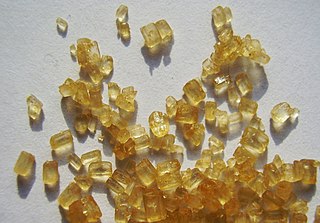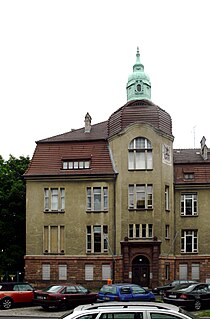
Sugar is the generic name for sweet-tasting, soluble carbohydrates, many of which are used in food. Table sugar, granulated sugar, or regular sugar, refers to sucrose, a disaccharide composed of glucose and fructose.

Confectionery is the art of making confections, which are food items that are rich in sugar and carbohydrates. Exact definitions are difficult. In general, though, confectionery is divided into two broad and somewhat overlapping categories, bakers' confections and sugar confections. The confectioner does the categories of cooking done by both the French patissier and the confiseur.

A sugar beet is a plant whose root contains a high concentration of sucrose and which is grown commercially for sugar production. In plant breeding it is known as the Altissima cultivar group of the common beet. Together with other beet cultivars, such as beetroot and chard, it belongs to the subspecies Beta vulgaris subsp. vulgaris. Its closest wild relative is the sea beet.

A sugarloaf was the usual form in which refined sugar was produced and sold until the late 19th century, when granulated and cube sugars were introduced. A tall cone with a rounded top was the end product of a process in which dark molasses, a rich raw sugar that was imported from sugar-growing regions such as the Caribbean and Brazil, was refined into white sugar.

Brown sugar is a sucrose sugar product with a distinctive brown color due to the presence of molasses. It is either an unrefined or partially refined soft sugar consisting of sugar crystals with some residual molasses content, or it is produced by the addition of molasses to refined white sugar.

Trinidad is a town in the province of Sancti Spíritus, central Cuba. Together with the nearby Valle de los Ingenios, it has been a UNESCO World Heritage site since 1988.
Degrees Brix is the sugar content of an aqueous solution. One degree Brix is 1 gram of sucrose in 100 grams of solution and represents the strength of the solution as percentage by mass. If the solution contains dissolved solids other than pure sucrose, then the °Bx only approximates the dissolved solid content. For example, when one adds equal amounts of salt and sugar to equal amounts of water, the degrees of refraction (BRIX) of the salt solution rises faster than the sugar solution. The °Bx is traditionally used in the wine, sugar, carbonated beverage, fruit juice, fresh produce, maple syrup and honey industries.

Panela or rapadura is an unrefined whole cane sugar, typical of Central, and of Latin America in general. It is a solid form of sucrose derived from the boiling and evaporation of sugarcane juice. Panela is known by other names in Latin America, such as chancaca in Chile and Peru, piloncillo in Mexico. The name piloncillo means little loaf, because of the traditional shape in which this smoky, caramelly and earthy sugar is produced. It has far more flavor than brown sugar, which is generally just white sugar with a small amount of molasses added back to it. Just like brown sugar, there are two varieties of piloncillo; one is lighter (blanco) and one darker (oscuro). Unrefined, it is commonly used in Mexico, where it has been around for at least 500 years. Made from crushed sugar cane, the juice is collected, boiled and poured into molds, where it hardens into blocks. Panela is also known as rapadura in Portuguese. Elsewhere in the world, the word jaggery describes a similar foodstuff. Both of them are considered non-centrifugal cane sugars.

Muscovado, also khandsari and khand, is a type of partially refined to unrefined sugar with a strong molasses content and flavour. It is technically considered either a non-centrifugal cane sugar or a centrifuged, partially refined sugar according to the process used by the manufacturer. Muscovado contains higher levels of various minerals than processed white sugar, and is considered by some to be healthier. Its main uses are in food and confectionery, and the manufacture of rum and other forms of alcohol. The largest producer and consumer of muscovado is India.
A polarimeter is a scientific instrument used to measure the angle of rotation caused by passing polarized light through an optically active substance.

Puʻunene is an unincorporated community in the central part of Maui, Hawaii, near Kahului with a population of around 50. Although the land is fairly level, the Hawaiian language name Puʻu nēnē means "nēnē goose hill".

Barley sugar is a traditional variety of boiled sweet, often yellow or orange in colour, which is usually made with an extract of barley, giving it a characteristic taste and colour. The OED describes it as "a confection, usually in twisted sticks, made from sugar, formerly by boiling in a decoction of barley." Barley sugar is very similar to clear toy candy and to hard caramel candy in its texture and taste.

José Eusebio Colombres was an Argentine statesman and bishop. He was a representative to the Congress of Tucumán of 9 July 1816 which declared the Independence of Argentina, and is credited with the foundation of the important sugar cane industry in Tucumán Province.

Valle de los Ingenios, also named Valley de los Ingenios or Valley of the Sugar Mills, is a series of three interconnected valleys about 12 kilometres (7.5 mi) outside of Trinidad, Cuba. The three valleys, San Luis, Santa Rosa, and Meyer, were a centre for sugar production from the late 18th century until the late 19th century.

The Sapporo Beer Museum is a museum located in the Sapporo Garden Park in Higashi-ku, Sapporo, Hokkaidō, Japan. Registered as one of the Hokkaidō Heritage sites in 2004, the museum is the only beer museum in Japan. The red-brick building was erected originally as a factory of the Sapporo Sugar Company in 1890, and later opened as a museum in July 1987. The building also houses the Sapporo Beer Garden in the south wing.

Sugar was first produced from sugarcane plants in Northern India sometime after the first century AD. The derivation of the word “sugar” is thought to be from Sanskrit शर्करा (śarkarā), meaning "ground or candied sugar," originally "grit, gravel". Sanskrit literature from ancient India, written between 1500 - 500 BC provides the first documentation of the cultivation of sugar cane and of the manufacture of sugar in the Bengal region of the Indian subcontinent. The Sanskrit name for a crudely made sugar substance was guda, meaning “to make into a ball or to conglomerate."

Lolland is the fourth largest island of Denmark, with an area of 1,243 km2 (480 sq mi). Located in the Baltic Sea, it is part of Region Sjælland. As of 1 January 2013, it has 62,578 inhabitants.

The Sugar Museum in Berlin was devoted to the history and technology of sugar, is the oldest such museum in the world, having opened in 1904. It is now part of the German Museum of Technology. Until November 2012, it was housed in the Institut für Lebensmitteltechnologie in Wedding, Mitte.

Kopi is a type of traditional coffee originating from Singapore. It is a highly caffeinated black coffee served with milk and sugar. This drink has Hainanese roots, being also otherwise known as Nanyang coffee. Nanyang means ‘South Sea’ in Mandarin, and usually references to lands within Maritime Southeast Asia that are located south of the islands of Hainan and Taiwan.

The sugar industry subsumes the production, processing and marketing of sugars. Globally, most sugar is extracted from sugar cane and sugar beet.



















